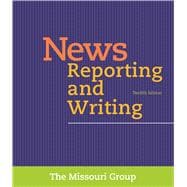Prepare yourself for a career as a reporter no matter the medium as News Reporting and Writing takes you through the essentias of reporting and writing, giving you a foundation fin the profession whether you end up working in print or digital media.

Note: Supplemental materials are not guaranteed with Rental or Used book purchases.
Purchase Benefits
What is included with this book?
Prepare yourself for a career as a reporter no matter the medium as News Reporting and Writing takes you through the essentias of reporting and writing, giving you a foundation fin the profession whether you end up working in print or digital media.
DON RANLY became head of the magazine sequence in 1976 (a position he held until 2004), just two years after he joined the Missouri School of Journalism faculty. Before making Missouri his home, Ranly worked for eight years in Wisconsin, Ohio and Indiana as a newspaper reporter, a magazine editor, a weekly columnist, a radio host and a television producer, director and host. Ranly’s broad experience is also reflected in his education: he has master’s degrees in journalism and speech from Marquette University, a certificate in film, radio and television from New York University, and a doctorate from the Missouri School of Journalism. During his 30 years of service at the school, he has conducted nearly 1,000 writing and editing seminars for press associations, corporations, associations and individual newspapers and magazines. He has also authored or co-authored five books and published several audiocassettes and videos on reporting, writing and grammar. In 1995, Ranly received a Mizzou Alumni Association Faculty-Alumni Award and was named the O.O. McIntyre Distinguished Professor of Journalism. Three years later, he won a University of Missouri Golden Chalk teaching award and co-authored Publication Editing (Kendall/Hunt). In 2002, he was named a Fellow of the International Association of Business Communicators; in 2003 he won one of the University of Missouri’s most prestigious teaching awards, the William T. Kemper Fellowship. In 2012 Ranly was named an "Icon of Education" by Ingram’s Kansas City Business Magazine.
The New copy of this book will include any supplemental materials advertised. Please check the title of the book to determine if it should include any access cards, study guides, lab manuals, CDs, etc.
The Used, Rental and eBook copies of this book are not guaranteed to include any supplemental materials. Typically, only the book itself is included. This is true even if the title states it includes any access cards, study guides, lab manuals, CDs, etc.